Ceci N'est Pas un Rando Bike
Last summer I test rode and reviewed a Rawland Nordavinden, which I liked very much. At the time I was waiting for a similar frame (a prototype project) to be finished and it was unclear when that would happen. Could be soon, could be in another year, as these things go. In the meantime I kept borrowing bikes to do dirt road rides, which didn't feel right. So after giving it some thought, I bought the Nordavinden frame for personal use and built it up as an interim bike, with components destined for my own frame. Long story short, but for now the Rawland remains. I got used to it, I like it and can't bring myself to dismantle it.
The frameset is the same one described earlier, so I won't go into detail again. But quick summary: It is steel, with thin wall standard diameter tubing and low trail geometry, made to fit 650Bx42mm tires and to accommodate sidepull or centerpull brakes. The way I set up this bike is considerably different from the demo model I tried last summer, so I'd like to share my impressions of this version.

Rawland owners have their own newsgroup called rCOG, which I browse with interest. One common theme I've noticed there is that they like to keep the weight of their builds down. I did this to some extent as well, but didn't take it as far as one could. For instance, I went for lightweight wheels, but didn't fret as much over the other components. Still, the bike - before fenders, front rack or handlebar bag, but including saddle, pedals, bottle cages and bar tape - weighed a respectable 22lb, according to Harris Cyclery's scale. Once the final accessories were added, the weight rose to 25lb. That is not bad for a bike of its type, though it's possible to do better (for a price).
The wheels were built around Pacenti PL23 rims, with a Schmidt SON dynohub in the front and a White Industries rear hub, with a Campagnolo road cassette. The tires are the 650Bx42mm Grand Bois Hetres. Some have pointed out that this bike looks like it has fatter tires than the one I tried last summer, but that's only because these are cream and the others were black. White tires tend to look larger; it's an optical illusion.
The drivetrain is a hybrid of older Campagnolo Chorus (not sure what year, but it was when Chorus was still a 10-speed group), and a White Industries VBC road double. The goal here was to achieve super low gearing without weighing down the rear wheel with a mountain cassette, as well as allowing me to use my favourite shifters. As far as smoothness of operation and reliability, the setup works okay, but I would not go so far as to recommend it (or any other hybrid drivetrain I've tried to date) to others. More on this in a later post; it could be a bit of a rant.
But as far as gearing, the setup is heavenly. I have 42/28t rings on the crankset, and a 12-29t cassette in the rear. On pavement, I mostly use the big ring, and it provides a decent range. On dirt, I switch to small and it also provides a decent range. Having a sub 1:1 gear is wonderful. I tend to pedal at a high cadence, so climbing hills on an overgeared bike is a sure way to dampen my enjoyment of a ride. With the low gearing here, my legs always feel good on climbs; I feel like I could go anywhere.
The brakes are Paul Racers, and I reviewed them here. Honjo fluted fenders.
When riding on dirt and gravel, I prefer the Selle Anatomica saddle for the extra bit of give it provides. I've reviewed SA saddles before (here and here), but might need to post an update.
In the front I have a Nitto Mark's rack and a modified VO Campagne handlebar bag, which I use as a camera bag. The headlight is a Schmidt Edelux, on a DIY bracket. I have not installed a dynamo tail light yet, but when I do it will be the Spanniga Pixeo.
Cane Creek headset, Velo Orange stem, Grand Bois Maes handlebars, Cinelli cork tape. In retrospect, I think the white tape was an aesthetic mistake on this bike, but I'll keep it while it lasts.
Not clearly pictured here are my Crankbrothers Candy pedals, and King bottle cages (made by these guys), with Lezyne mini-pump attached. When I ride this bike, I typically keep tools in the saddle wedge and camera stuff in the handlebar bag. If I were doing a multi-day trip, I would substitute a large saddlebag for the wedge. I do not plan to install a rear rack.
[image by Pamela Blalock]
The role of this bicycle seems to confuse a lot of people. I've been repeatedly asked why I did not ride last weekend's Permanent on it, since it's the prototypical "rando bike." But it's not a rando bike, at least not to me. I prefer to do paved rides - be they short or long - on my lightweight skinny-tire roadbike. On pavement, my roadbike is faster and feels better; I get less tired and find it easier to keep up with others. This may not be the case for everyone, but it is for me. However on dirt and gravel, this dynamic changes and a fat tire bike feels both more comfortable and more efficient. I also find the Rawland's distinct handling to be helpful on twisty unpaved rides, which in turn allows me to ride more confidently, relax and enjoy myself more.
So the Rawland (and any similar bike it might eventually be replaced with) is for unpaved riding. It is also a "camera bike," for long rides where I go exploring and photo-scouting. These two use case scenarios sometimes, though not always, overlap. The frame feels springy, but not noodly. A full handlebar bag does not seem to impact handling in any noticeable way, but the bike also handles just fine without it, as well as with weight on the rear only. In general (another rant-inducing topic best saved for another post), I am coming to the conclusion that handlebar bag setups are unnecessarily bulky and troublesome. I would not go this route, if it weren't for my desire to carry heavy cameras on the front of the bike. That said, I enjoy my setup, despite the trouble it took to install everything to my satisfaction and the extra weight.
I've now had the Rawland since September, though I did not ride it for a period from January till late March due to snow. My favourite things about it are the handling, and that it allows me to carry my big cameras in the front. It is a fine bike and a fun bike - though I'll be remiss not to note that others who try it don't always like it; the phrase "hinged in the middle" is used. It seems the low trail thing is really a matter of taste (and/or of getting used to).
With unpaved rides becoming more popular than ever, lots of cyclists are looking for appropriate bikes and the Rawland is a great option. In addition to the Nordavinden, there is now also the Stag model, which is made for cantilever or v-brakes, and for 650B wheels in all sizes (whereas only the smaller Nordavinden comes in 650B). And for an entirely different take on bikes for unpaved riding, watch for an upcoming review of the Honey Cyclocross bike.

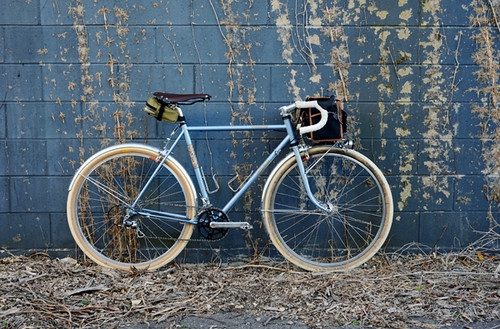
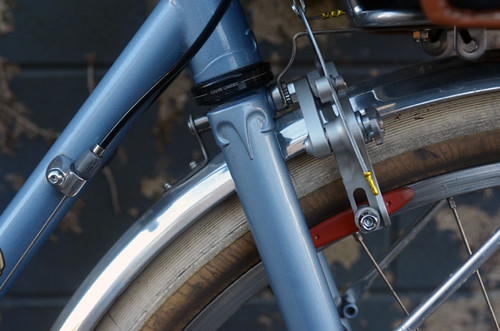
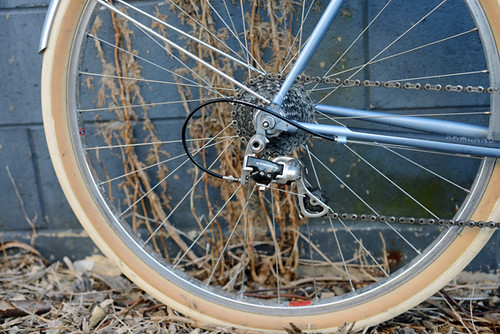
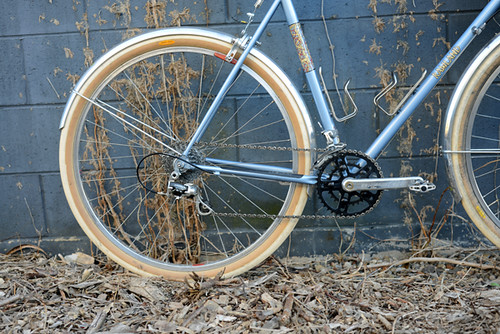



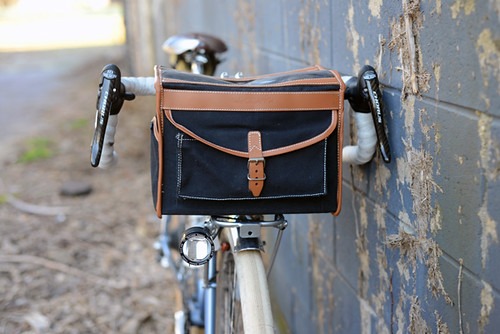
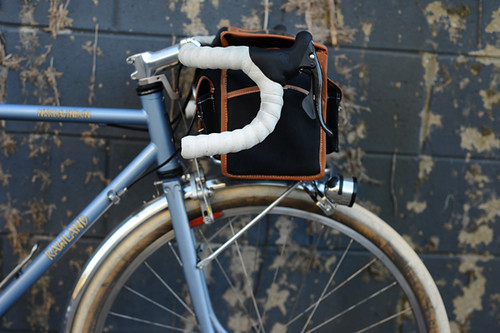
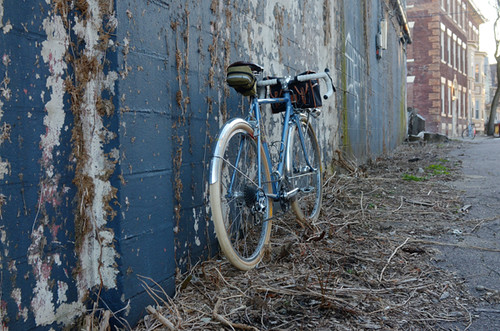

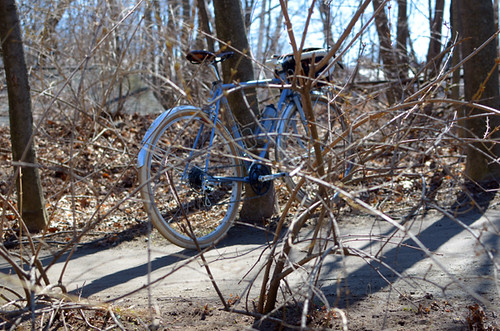
Looks versatile and comfortable....So I'm guessing around $2500 for this set-up?
ReplyDeleteHard to say, as many parts here were traded, used or NOS. Otherwise I'd do things differently; not sure I actually recommend the setup shown. Assuming that a rider has no strong brand/model preferences, I think a cleaner way to go that is also easier to price would be SRAM Apex (or Rival) with a wifli rear derailleur, a 50/34t and a big cassette. Same wheels though; those are nice.
DeleteMy own Nordavinden is a bit bigger, so it runs 700c wheels. It has Apex brifters, derailleurs, and 11-32 cassette, with a 46-30 crankset created by removing the original 52/42T rings from a Campy Record triple crank, and installing a 46T middle ring with no outer ring. It all works pretty well together. The Q-factor is not super narrow, but that's OK by me. If I was starting from scratch I think I'd use the Herse crank with 44/28 rings just to save some weight. No front bag or rack, I came to the same conclusions on weight / benefit for a bike that never sees a significant load.
DeleteI have an rSogn that gets used for errand running, that one got a front rack and Ostrich front bag.
Bill
That's great that you have both the Nordavinden and the rSogn.
DeleteI wouldn't mind finding me a small used Drakkar frame just for fun and setting it up with some old parts... maybe single speed with super fat tires and those half-drop handlebars... But I digress!
"The role of this bicycle seems to confuse a lot of people. I've been repeatedly asked why I did not ride last weekend's Permanent on it, since it's the prototypical "rando bike.""
ReplyDeleteWhat is wrong with people anyway? Your Seven is way more efficient, dialed in in a way the Rawland can never be. 23mm vs. 42mm tires make a dif? Of course!
Way, way more important than how the bike looks is how the rider will feel at the end of the brevet; the bike that is the combo of most efficient, most stable/ability to hold a straight line on its own with the rider is seeing cross-eyed, most comfortable with the ability to carry whatever wherever the rider wants is the ideal bike.
"The goal here was to achieve super low gearing without weighing down the rear wheel with a mountain cassette, "
This statement is bizarre. A mountain cassette is heavier to be sure, but negligible in the context of the entire bike. Weight distribution? You have a big camera and stuff on the front, the thing will balance fine with or without micro-managing cassette weight.
I probably agree with the last bit. More on this in the hybrid drivetrain rant post.
DeleteJeff Jones addresses the MTB cassette weight issue by reducing rings to 6. He also modifies the body so it will work on single speed hub, allowing a dishless wheel.
DeleteThe range as sold is more off road, but I see no reason you could not swap cogs, albeit you may need to use friction shifting.
I have a wheel built up with the Jones cassette on a King hub waiting for a new frame.
http://www.jonesbikes.com/Parts/6-Speed-Cassette-XT/vmj_funky.tpl.html
BTW the cassette thing is another center of gravity discussion. You can run, but you can't hide.
ReplyDeleteAnother thing: your saddle is way forward on a setback seat post - that's a lovely bike no-no.
ReplyDeleteYou're also proving your earlier sta micro-managing < actual riding experience.
Yeah, the post was meant for a specced-for-me frame with a steeper STA than the Rawland. Although the SA saddle really exaggerates the effect; it's a long saddle and I tend to sit at the back.
DeleteAren't those Grand Bois Maes "Parallel" copies great? I cover mine with Lizard Skin DSP tape, grippy, cushy, but not squishy (I don't wear gloves).
ReplyDeleteOverall it's my favourite shape of drop bar of any I've tried so far. Every position feels just right. The bars on my Seven are very similar, but with shorter reach.
DeleteHey, for a Rawland this post should be titled "Dette er ikke rando sykle!"
ReplyDeleteI'm heading off to the Bing Translator site, to see how one says "that's not a rando bike" in Mandarin. Of course, Rawland HQ is in Cali, so we could probably just leave it in English. Funny thing about this article's title: I haven't gone over the build that closely, but I feel confident that there isn't a single French component on the thing. And certainly not any Norwegian parts...
DeleteGreat looking bike.
ReplyDeleteI'm not seeing a lot of clearance between fenders and tires - do you find this causes problems on muddier roads?
I look forward to your handlebar bag rant. Personally, I don't understand what seems to be a recent renewed interest front racks/bags. I strongly dislike carrying anything on my handlebars - first, because it makes the front of the bike flop around, regardless of trail (especially unwieldy when you're trying to load it up before riding). Second, because I like to have a clear view of my front tire and the road, particularly where the two meet. There is always so much debris on the roads here, not to mention potholes of all sizes, I'm constantly having to make little swerves to avoid punctures (even so, I could open a hardware store with all the bits I've pulled out of my tires). I like to be able to see exactly where my wheel is going, which isn't possible with a bag of groceries sitting in front of the bars (at least not on the bikes I've ridden, perhaps others are different).
This is the first time I've used Honjo 650B fenders (it was always VO Zeppelin before), and I was surprised by this also. No problems so far, but then I don't generally ride through deep mud on this bike. I am more worried about a stick getting caught in there. Fenders on roadbikes! Another rant : )
DeleteInteresting that you decided to stick with this bike. Now that it's getting warmer you must be tired of projects and want to ride! Or do you have reason to believe that the Rawland performs better than its potential replacement?
ReplyDeleteIt is mostly the former. I do not have reason to believe the Rawland performs better than its potential replacement, but I also have no reason to believe it performs worse. Basically, my reasoning is that I finally have a dirtroad bike set up the way I like. It rides fine. Why take it apart. My hope is that eventually I will collect enough components to build up the other bike simultaneously, so that at least I can compare them and never be without an assembled bike. Then I can decide which to keep. But at this rate, not sure when that will become realistic.
DeleteHow much smaller is this bike than your Rivendell? Hard to tell with the way both companies list the sizes. Thanks,
ReplyDeleteRon.
Well, my (former) Rivendell had a 57.5cm top tube; the Rawland's is 54cm. But the Riv had different ST and HT angles, which in practice diminished the difference in reach some. The Riv also had a taller head tube (by how much I am not sure, but looking at pictures it looks like at least a 1" difference).
DeleteNice review. Never heard 'hinged in the middle' before but I like it.
ReplyDeletePeople interested in the White Industries crank may want to consider their Quick Draw Crank Set (pedal quick release) option.
I have the White Quick Draw cranks on my light tour bike. It makes loading on Amtrak and the local rail easier without adding much weight. Certainly a whole lot less than a pedal wrench.
I'm curious about this bike. What would you say are the biggest differences between this bike and your previous Sam Hillborne? (I'm thinking of trying my hand at randonneuring but the only bike in my garage that seems quasi-appropriate is a Hillborne. Maybe I need an excuse to buy a new bike? :-)
ReplyDeleteI've seen people do brevets on a Sam Hillborne.
DeleteAside from the size (see two comments up), the differences between the SH and the Rawand is the tubing, the geometry and the handling. The Rivendell is made of stouter tubing, has more relaxed angles all around, longer chainstays and midtrail front end geo. It is hard to describe the difference in handling if you've never tried low trail, but I guess the Riv is more "neutral" whereas the Rawland is very particular, especially when turning.
Of all the many very wonderful bikes that have appeared on this blog, this is the one that makes me want to flee the office, find some gravel, and ride.
ReplyDeleteune bicyclette, un velo
ReplyDeleteWhatever this is, I like it!
ReplyDeleteSo, it seems that after a couple tries you've nailed down you're 'dirt road' bike, and your 'road' bike, and your dressy mixte city commuter, as well as your regular city commuter.....Is the fixed gear bike still in play? What about all your other bikes?
ReplyDeleteI suspect that I will always have loads of bikes around, as I continue to get demo bikes for review, project bikes, orphan vintage bikes, etc. But for purely personal use, I have a Brompton, a roadbike, a fixed gear, and a dirt roadbike.
DeleteSo what is this mixte you continue to ride? Yours? The photos show your trademark saddle, fenders, racks, and generator wheels.
DeleteIt's a prototype bike that I designed and a friend built. I am not ready to write about it yet, and not sure of its ultimate fate.
DeleteI have a fairly similar build on my Rawland rSogn 650B machine-- Pacenti Pl23s, Hetres, White (MI5) rear hub, and a Sondelux front hub -- but I went with a Rene Herse 44/30 crank and SRAM for the rest of the drivetrain. Oh, and cantis, of course. I haven't finished putting everything together, so I can't yet offer an opinion on the whole low-trail experience.
ReplyDeleteLooking forward to it! I would love to compare the Nordavinden to the rSogn, but alas the latter is sized too big for me.
DeleteHave you built up and road the frame and fork you hand built? Maybe I missed that report. Just curious how it turned out on the road that is.
ReplyDeleteNot yet. But it's not road; it's a functionally identical frameset to the Rawland - so, assuming nothing is wrong with it, it will replace the Rawland if and when I do build it up.
DeleteI should proof my posts. Have a little more faith in your metal work. Paint that baby in a fun way and get her on the rode. The Rawland is nice, but a little boring in the paint scheme.
DeleteBoring in the paint scheme, eh? The frame I made is powdercoated puke green : )
DeleteI am okay with trusting the metal work; Mike Flanigan was watching me like a hawk. There is a mistake visible (exaggerated rather than hidden by the powder!) which bothers the heck out of me, but that's okay. By "wrong with it" I meant the tubing and geo combo; you never know how a bike will handle until you build it up and ride it.
OK. Now I understand, but that powdercoat will last forever! Maybe you could pick up a variety of Testers paint and cover the puke. You should get that out for a shakedown. As Lance would say, "Just do it".
Delete" I am coming to the conclusion that handlebar bag setups are unnecessarily bulky and troublesome. I would not go this route, if it weren't for my desire to carry heavy cameras on the front of the bike." Hmmm, like many people, I keep reading enthusiasm for handlebar bags, at least of the 'rando' style, sitting on a small front rack. But you have tried more than one and are becoming disillusioned. Very interesting.(Certainly all that tie rap attachment of your current bag seems to defeat the virtue of quick and easy on-and-off.) I look forward to reading your comments, or rant.
ReplyDeleteTo be clear I am not talking about the bags themselves, but about the whole setup, as it is used on bikes which are otherwise lightweight "performance" machines. Most rack+bag+hardware combos available today will add 2lb+ of weight to the front of your bike unless modified considerably. So while the setup makes sense on a touring bike, if you're using a 2lb rack+bag on a timed brevet to carry what for most riders amounts to a snack and a lightweight jacket, it seems less logical. The setups are also more complicated to install than people let on; not every rack/bike/decalleur/stem/headset/shifter/etc/etc/etc combo works, and if you have a small bike this is especially so.
DeleteI like the idea of a handlebar bag, for the easy access to items it provides. But I think the system could use some improvement in the weight and complexity department.
^i said this before you did nya nya.
DeleteAnd why is everyone using "rant" today anyway. Our hostess doesn't rant, she mildly complains.
I'm the one who rants! Get it straight!
For off the shelf setups, you're right about the 2+ lbs weight addition. But with a lightweight rack (thinking Grand Bois M13 or full custom) and a small rando bag without heavy duty stiffeners or decaleur, you can get that number down to a pound and a half. A small saddlebag itself can be between 1/2 and 1 lb.
DeleteThe other thing is, not all brevets are 100k and take half a day. For that length of a ride, I'm perfectly happy to use a small saddlebag and make maximum use of my jersey pockets. But for day-long centuries or anything "200k" or longer, I would strongly prefer a small front bag to hold more things and access them conveniently. Basically, the longer the ride, the more convenient it is to have a front bag with rack setup.
Yes, I was talking about off the shelf. And remember, the GB rack is out for a bike like the Nordavinden, since the frame doesn't have canti mounts.
DeleteSmall front bag for 200K or longer - yes, me too. But my point is there is no need for it all to weigh so much just to carry the said small bag. When I look at what most riders have in there, even at the 600k ride I was staffing, the contents weigh less than the setup.
I'm curious to hear this upcoming rant on hybrid drivetrains.
ReplyDeleteMe too! Jim Duncan
ReplyDeleteOne thing you might consider is ditching the big heavy cameras and going with something lighter. Gone are the days when big cameras = better pictures. This would chop a lot of bulk and weight off of the bike and make it handle better in the process (I fail to see how a huge saddle bag or handlebar bag could possibly improve handling ;p - I no longer even carry a tool bag under my saddle, it all goes in the jersey pockets since even an inner tube, patch kit, tire levers and small multitool messes up the center of gravity).
ReplyDeleteBeing both a bike and camera nut myself, I understand the quandry of wanting to take a "real" camera with me on the bike for exploring and photo trips.
What I settled on for my go anywhere camera was one of the smaller fuji cameras (an X10) which does a fine job. The big metal dslr stays home when the bike comes out. Today, with what is out there now, I would go with the fuji X100s as a good all in one camera. While it has a fixed lens, its IQ is simply stunning. It is also small. And light. And fits your particular style of retro chic better than any dslr could ever do (as an added bonus).
Something to think about anyways.
So you're telling me to ditch my medium format film cams and my full frame DSLR with lenses? I don't think so Mister! I just need to get a little faster : )
DeleteOf course not. I am suggesting though that a smaller lighter camera for longer rides where cycling is the main goal not photography might make more sense in that context.
DeleteCeci n'est pas un commentaire de la Galerie d'arachide.
ReplyDeleteI too am interested in the rant.
I have had my own frustrations with a hybrid drivetrain as of late, setting up a SRAMano system on my nephew's c.1991 Schwinn MTB.
(I suspect you had better base knowledge, advice and luck.)
The Rawland sounds like a fin bike overall, and I really look forward to the comparison with the Honey.
I'm curious to here all the rants you mention. Maybe in addition to "Mailbag Mondays" you can institute "Andy Rooney Fridays."
ReplyDeleteIf all you need to ride a brevet is a snack and a lightweight jacket, then you probably don't need a handlebar bag.
ReplyDeleteAround here, many brevets start early in the morning, when it's chilly. During the day, it can heat up. So you need to take off layers of clothes and stash them. Many of us have found it more efficient to carry our food, rather than shop for it along the way. A handlebar bag is very useful in that scenario.
For general riding, I just love the extra capacity. On a racing bike, I can't even return a DVD to the library (it doesn't fit in my jersey pocket), much less buy some veggies at the farmers' market on the way home from a long ride.
Right. As with everyone, much of my preferences are specific to my location, style of riding, distances, etc. For instance, I do not like mixing "sporty" cycling with commuting, so there have been very few times when I wished for more carry capacity on my roadbike.
DeleteIf I start to do substantially longer rides that require carrying gear yet are timed, I will have to wait and see how my bike preferences evolve. Interestingly, observing local riders do even events as long as the 600k I staffed last summer, very few seemed to be carrying extra clothing and substantial gear. I imagine there is a difference between the climate and temp changes in Seattle and here, especially in the mountains.
I want to hear the drivetrain rant too. Because this looks just like a setup I would try and your experience will be useful. I would expect this one to work but would not expect it to be perfect. Chorus was designed with larger diameter chainrings in mind and the 42/28 creates a whole new group of angles. Or that's my guess.
ReplyDeleteThere is no complete set I know of that would do what you've done here. Maybe some 29er set would come close. A 29er group on this bike would hurt my eyes.
42x12 is a sensible way to start. I've told a hundred bike owners the whole drivetrain will arrange itself better if they forget about a top gear that will never be used anyway. No one ever listens. You got it just right on your own.
The fenders on your bike are quite narrow - that model of Honjo fenders is designed for tires up to about 32 mm wide. For 42 mm-wide Hetres, Compass Bicycles recommends 58 to 60 mm-wide fenders. They fit the tires perfectly.
ReplyDeleteThat is my suspicion, though they were labeled as the wide version.
DeleteHonjo fenders usually are labeled by their width in millimeters. There are multiple models in all kinds of widths. For example, we sell 3 different models of 700C fenders to fit the different tires we sell...
DeleteI am familiar with the model you have on your Rawland - I love the shape, but it's too narrow for the Hetres I run on my bike...
Idle curiosity. Was the title of this blog post a reference to the famous Magritte painting?
ReplyDeleteGetting itchy to do the kind of riding you describe for this bike. Here in Minnesota we're waiting for the onset of our next April blizzard.
I find the "hinged in the middle" complaint interesting. I associate it with folding bikes--and with long-wheelbase bikes made with light tubing and loaded in the rear.
ReplyDeleteI really like the way your bike looks. Are you going to do a "bike family" portrait?
To me it's an interesting phrase, namely because I do not feel it - the bike feels more natural and intuitive than those with mid or high trail geo!
DeleteBike family portrait - ha, maybe some day : )
Thanks for the post. I'm currently considering a pre-order of the Stag. But my question is actually about that little wedge saddlebag: What is the maker?
ReplyDeleteIt's a Jandd Mountain Wedge
DeleteCould you give your thoughts on the workmanship of the frame. Did you build this up yourself or have your LBS do it? Was there a need to "clean up" the frame before installing the components? For example re-chasing the BB.
ReplyDeleteIt was put together by Jim at Harris Cyclery with me there "helping" (getting in the way). I would describe the workmanship as "as good as it gets and then some" for a frame of its price category; no rechasing the BB as far as I know.
DeleteI'm trying to warp my head around the frame specs for sizing both the Stag and Nordavinden. The reach and stack all seem fine but the stand over is too high for the smaller sizes. Why they would choose a level top tube (or almost level) with only four sizes doesn't really make sense. IMO, this choice really limits rider size only for strictly aesthetic reasons. For reference, I'm 5'4" with PBH of 77cm so the small frame still seems too big.
ReplyDeleteMust add that I have found it almost impossible to communicate to anyone at Rawland (via email or blog). I understand they don't have a "traditional" store but waiting two months to get a reply by email is simply ridiculous.
So I almost exactly have same setup on my 54 650b nordavinden. I had the Tektro long reach brakes but I'm a hefty guy and they didn't brake well so I replaced them with the Paul Racer. They stop so much better however the brake pads seem awfully close to the Hetre. Have you had any issues as the pad wears down? Any advice appreciated.
ReplyDelete